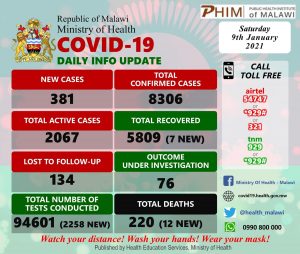
*As produced by the Government of Malawi through the Ministry of Health in August 2020
Acknowledgement
The Ministry of Health has developed this guide on Home-Based management of persons with asymptomatic and mild Covid-19 symptoms as part of Malawi’s response to the COVID-19 pandemic at community level.
This guide provides the policy direction towards COVID-19 prevention and control with support from different stakeholders and structures at community level. Therefore, the Government through Ministry of Health is committed to implement the recommended measures herein for COVID-19 prevention and control.

The Ministry is grateful for and recognizes the contributions of Clinical Services department, Community Health Services Section, Quality Management Department for the development of this guide and tirelessly providing direction, support, leadership, and commitment.
Further, the Ministry is thankful to Essential Health Package technical working group for providing valuable inputs to the development of this guide.
This guide was developed with consultations and in collaboration with other institutions to reflect a comprehensive and integrative approach to COVID-19 response at community level.
Introduction
The majority of the suspected or confirmed Coronavirus (COVID-19) patients present mild signs and symptoms which can be managed at home.

Situation report as of Saturday evening
Therefore, patients, suspected individuals and household members should understand and access the basic for management services of COVID-19 infection at community level in particular home.
Also, people should ensure that prevention and control interventions are continuously implemented and adhered to such as personal hygiene, basic Infection Prevention and Control (IPC) measures when caring for the patients in order to avoid the spread of the infection among household members is properly done.
Objectives of the guideline
* To support patients with mild Covid-19 symptoms to improve and recover from the infection
* To prevent spread of infection to other members of the family, and also the community at large
* To provide guidance to Community Health Workers and various community structures on their contribution/role during home management of Covid-19 patients with mild symptoms,
* To ensure that necessary support is provided at the right time to the patient and family, including linkage to a health facility.

Signs and symptoms of mild COVID-19
The most Common COVID-19 symptoms reported
* New continuous cough
* Fever
* Fatigue
* Muscle aches
* Nasal congestion and runny nose
* Sore throat
* Shortness of breath when moving around
* Sputum production
* Loss of appetite/taste/smell
* Diarrhea

Coronavirus alert
Who is at risk of severe disease
Everyone is at risk of COVID-19 infection. However, the following persons are at higher risk of severe disease:
* Older than 60 years
* Overweight and unfit
* Multiple medical conditions
* Chronic conditions that are not well controlled i.e Hypertension, Diabetes Mellitus, Chronic lung diseases, cancers, HIV and TB
Management of COVID-19 positive case at home
If a person is diagnosed with COVID-19, or has mild symptoms but cannot get tested, they should be isolated and managed at home. The person needs to avoid contact with other people for: 10 days after the test if they have no symptoms; 10 days after the symptoms started if they have mild disease.

Infection prevention measures
* Separate yourself from other people in your home, in a well-ventilated bedroom. Your family should not stay or sleep in the same room with you.
* Use a separate bathroom. If you have to share a bathroom, clean after every use.
* Avoid sharing items and the same spaces with other people and clean surfaces often.
* Wear facemasks to help prevent the spread of the disease to others.
* Cough or sneeze into the fold of your elbow. Alternatively, cover your mouth and nose with a clean cloth when you cough or sneeze and dispose of tissue in a dedicated bin.
* Clean your hands often with soap and water for at least 20 seconds or with alcohol-based hand sanitizer that contains 60-95% alcohol. If you do not isolate yourself correctly, you may infect others.

Coronavirus alert
Strengthen Your Immune System
The patient needs to ensure that the immune system is strengthened by doing the following;
* Eat healthy meals from the Malawi six food groups. Eat more of the following foods to boost your immunity and also aid healing (oranges, lemons pawpaws, bonongwe, Luni, Chinese, cabbage, tomatoes, chidede, dried chambo, dried usipa, dried mlamba, beef, beef liver, sweet potatoes, food from millet, beans, chick peas, groundnuts, and many other foods from the six food groups. These are sources of vitamin C, vitamin B, and Zinc.
* Drink enough water, sleep well, get plenty of rest but also remember to stay active.
* Get enough sunlight to make vitamin D.
* Stop smoking immediately if you currently smoke
* Make sure your underlying medical conditions are well controlled:
* Take your hypertension, diabetes and other medicines correctly and on time.
* Monitor your blood pressure and sugar if you have the equipment at home.

Coronavirus alert
Cold and Flu Remedies to Relieve Symptoms
The following Cold and Flu remedies to relieve the symptoms should be used;
* Take Panadol for fever and pain relief.
* Drink warm honey and lemon water or use lozenges to relieve sore throats.
* Do take warm water and salt gargles twice daily.
* Steam or use humidifier with eucalyptus or Vicks as dry air can be used if tolerated by the patient
* It is not harmful to use traditional remedies like black seed, turmeric, ginger and other natural substances known for their anti-inflammatory properties.
* Breathing exercises to clear your lungs and improve flow of oxygen should be done regularly

Coronavirues alert: Respect to health workers
If you feel a little short of breath
* DO NOT take steroids or hydroxychloroquine or any medicines you have heard of in the media. Many of these treatments have not been proven to work and some are reserved for seriously ill patients who are being treated in hospital
* Sleep on your stomach for as much as possible with your head turned to the side (prone position).
* It helps to prop a pillow lengthwise underneath your head and chest for this.

You can also cycle between laying on your belly, on your side and sitting up:
1. 30 minutes –2 hours: laying on your belly
2. 30 minutes –2 hours: laying on your right side
3. 30 minutes –2 hours: sitting up
4. 30 minutes –2 hours: laying on your left side
5. Then back to Position 1 and repeat the cycle
When Should You Seek Medical Help?
* If your symptoms are worsening.
* If your symptoms have not improved after 7 days.
* If you become confused or have difficulty concentrating.
* If you develop a new fever or your fever returns.
* If you develop chest pain.
* If your breathing becomes difficult, and the number of breaths you take in one minute (respiratory rate) is more than 25.

If your oxygen level on the pulse oximeter is lower than 92%, call on artel mobile on 54747 or *929# or 321 on TNM or inform the nearest health worker 929 to receive assistance.
What Should the Rest of Your Family Do if You have COVID-19?
* All close contacts should quarantine for 10 days from the day of your positive test.
* If any family member develops any symptoms it is not necessary for them to be tested as well. They should be treated as if they are positive and follow the same advice.
* Avoid stigmatizing and discriminating others because they are suffering from COVID- 19.
* Stay safe and listen to your health workers advice and avoid confusing or misleading social media information.

Role of communities in Home based management of COVID-19 patient
Community engagement is central to any public health intervention even more significant during public health emergencies.
Hence, community plays a very crucial role in the management of persons with mild Covid-19 infection at home.
The strong community engagement depends on community structures, community leaders and communities that is well trained on COVID-19 response and will provide the necessary assistance.

Coronavirus Alert
Role of Community Health Care workers
* Provide the necessary information of COVID-19 infection management to patient and family members
* Provide psychosocial support to the patient and family members
* Promote adherence to infection prevention control measures at household level
* Ensure adherence to isolation guidelines and infection prevention measures
* Ensure that there are appropriate caregivers at home based on the state of the patient and that proper care and support is provided
* Routine assessments of the environment to ensure hygiene and sanitation within the compound, including access to safe water
* Link up with the health facility when the patient’s condition is worsening, of fever persisting for more than 7 days
* Link up with the District Rapid Response Team (DRRT) (or the Psychosocial expert if there is an increase in psychological issues.
* Link up with the DRRT where need for other interventions arise (eg, collection of specimens-initial or subsequent)
* Link up with necessary local structures and local leaders when there is resistance from the family to follow guidelines regardless of continues counselling and risk communication. (This should be after exhausting all engagement efforts with the patient or family)
* Provide information and contacts for the national GBV help line (5600) and /or Child Protection Helpline on 116 for use if they experience any violence or need further information on protection services

Coronavirus alert
Community Structures
Community engagement on COVID-19 response is critical as it allows community leadership to support in infection prevention and control. Hence, capacity building of community leadership and community Health structures on COVID-19 response should be prioritized.
This includes orienting community structures on COVID-19 response including their roles in the response. These include Village Health Committees, Community Health Action Groups (CHAGs), Health Centre Management Committees (HCMCs), Area Development Committees (ADCs), Village development Committees (VDCs), community burial team (CBT), among others.
* Provide the necessary psychosocial support to the family
* Ensure that isolation guidelines are always being adhered to

Coronavirus alert
* Liase with local leaders where stigma and discrimination against the family arise in the community
* Link up with the Community Health Worker where the patient’s situation gets worse.
* The community leaders and community structures should be used to engage the community in COVID 19 response based on their roles
* Existing community health volunteers e.g. mother groups, Care- groups, CHAGs, VHCs, faith groups, youth groups, etc. to reinforce hygiene promotion messaging (specifically focusing on hand hygiene and respiratory hygiene).

Coronavirus alert
* Liase with the local leaders where there is denial and non – adherence to isolation guidelines by the family and the patient. (This should be after exhausting all engagement efforts with the patient or family).
References
1. “Home care for Patients with COVID-19 presenting with Mild symptoms and management of their contacts, WHO, Interim guidance, 17 March, 2020
2. “10 things you can do to manage your COVID-19 symptoms at home”, CDC, May, 2020
3. “Operational guide for Community Health workers on COVID-19 response in Malawi’’, MOH, April, 2020

Coronavirus alert
